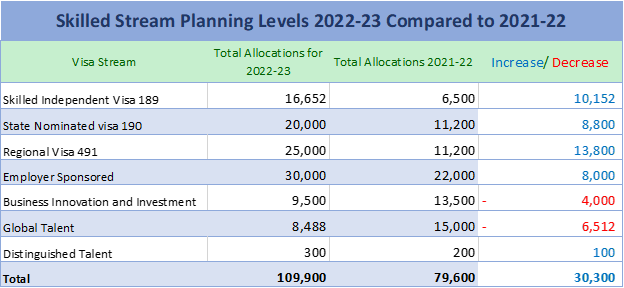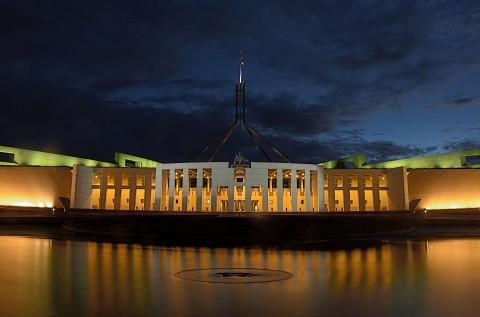The Australian government announced the new Migration Strategy, bringing about significant changes across various visa programs, including student visas, graduate visas, employee-sponsored visas, Business and Investor visas, and Global Talent visas. These are reforms, so not everything is going to be positive for you. We will give you a realistic summary to help you plan your life. The housing crisis has cast a massive shadow and has a lot to do with these cuts.
The government aims to bring migration numbers back to sustainable levels. The forecast for 2023-24 is 375,000, reflecting a reduction of 65,000 compared to the previous year.
Student Visas:
The migration strategy has many suggestions for international students. The changes for students include:
- Increased funding for visa integrity
- Introducing a Genuine Student Test to replace Genuine temporary entrant (GTE)
- Preventing course swapping
- Scrutinise lower-quality education providers
- Reducing the types of courses eligible for student visas with a focus on retaining tertiary university courses
- Increasing minimum English language requirements in early 2024
The test score required for a student visa will increase from IELTS (or equivalent) 5.5 to 6.0.
The test score required for students undertaking an English Language Intensive Course for Overseas Students (ELICOS) before their main course of study will increase from IELTS (or equivalent) 4.5 to 5.0.
The test score required for students undertaking university foundation or pathway programs that deliver reputable English language training will be IELTS (or equivalent) 5.5.
Temporary Graduate Visas:
One of the significant changes in the Migration Strategy that will affect many people is related to the Graduate Visa. The modifications include:
- Reducing the age eligibility from 50 to 35 years of age
- Reducing the length of stay
- Preventing graduates from moving back to student Visas
- Increasing the English language proficiency requirements - The test score required for a Temporary Graduate visa will increase from an IELTS score (or equivalent) of 6.0 to 6.5
- The extension of post-study work rights will no longer be available. Only applicants who studied in a regional area will be eligible for an extension
- Graduate Visa streams will be re-named as ‘Post-higher Education Work’ and ‘Post-Vocational Education Work’ streams to be more descriptive for the relevant applicants
- The ‘Replacement Stream’ of the Graduate Visa and the subclass 476 visa will be abolished
- The processing times for the ‘Post-Higher Education Work Stream’ will be backed by a 21-day service standard
- The work experience requirement for a Temporary Skills Shortage visa will be changed to give Graduate Visa holders more opportunities to move on to a skilled visa and have faster pathways to permanent residency
General Skilled Migration (GSM) Visas and Points System:
There is discussion about a new points system, but no decisions yet.
This is quite frustrating for many students and temporary visa holders currently in the system. We will provide updates when we have any more news about the GSM Visas.
Three new types of Temporary Work Visas:
Focus on visas with clear pathways to Permanent Residency (PR), aiming to eliminate the concept of being 'permanently temporary.' Introduction of the Skills in Demand Visa with three pathways: Specialist Skills, Core Skills, and Essential Skills.
Specialist Skills: This pathway recognises highly skilled migrants are hugely beneficial to Australia’s national productivity, including through their support of critical sovereign capabilities and potential to grow the skills and expertise of the Australian workforce. The Specialist Skills Pathway will be available to applicants who meet the general eligibility criteria (for example, be nominated by an
approved employer, meet the health and character requirements) and who are:
- in any occupation except trades workers, machinery operators and drivers, and labourers
- earning at least $135,000 (the Specialist Skills Threshold)
Core Skills: Most temporary skilled migrants will come through the Core Skills Pathway, which is designed to bring in the skilled employees Australia needs now and, in the future, to ensure that we can provide ourselves with the goods and services we need to support our way of life. The Core Skills Pathway would be available, for example, Registered Nurses, and will include trades workers, machinery operators, and drivers. The general eligibility criteria are:
- Individuals with the occupation on the new Core Skills Occupation List
- Individuals with a salary at or above the TSMIT
Essential Skills: A pathway for lower-paid workers with essential skills. The Government is primarily considering the pathway in the context of the care and support economy, which has become essential to the quality of life of Australians.
The distinction between the Core Skills Pathway and Essential Skills Pathway could be defined by occupation and pay. For example, in the care and support economy, Aged and Disabled Carers would have access via the Essential Skills Pathway, but most Registered Nurses or Allied Health Professionals would have access via the Core Skills Pathway. Both pathways, however, will be regulated to ensure that Australia is receiving the skilled workers it needs and that the employees concerned are protected from exploitation.
Employee Mobility:
The ability for temporary workers to move between employers, to remove employer exploitation. If the employment relationship with a sponsor ceases, visa holders will have 180 days to find another sponsor and can work during this period (currently the period is 60 days). Another change is about Trailing employer fees The Government will explore a model for employers to pay trailing charges and fees (e.g. monthly or quarterly) to make hiring a new migrant less onerous.
LMT Reform:
Reform in Labor Market Testing (LMT) requirements for the Temporary Skill Shortage (TSS) 482 visa, reducing the advertising requirements from three to two ads and removing Workforce Australia.
Priority for Regional Areas:
The government will collaborate closely with states and territories to enhance the precision in addressing regional population requirements. They will prioritize visas sponsored by employers in rural and regional Australia to enhance migrant pathways beyond cities.
They will review the regional migration settings and the Working Holiday Maker program to ensure migration supports development objectives in regional Australia and does not contribute to the exploitation of migrant workers.
Global Talent Visa:
The Global Talent program will focus on a select number of migrants in priority sectors who can make significant contributions to Australia.
With the new Specialist Skills Pathway, which will open new and streamlined pathways for highly skilled migrants, the Global Talent visa will be more sharply to a relatively small number of migrants who can make outsized contributions to the country.
Business and Investor Visas:
Potential closure of the Business Owner pathway, while the Significant Investor Visa program may continue with fine-tuning of investment options.
What will happen next?
The impact of these reforms will affect various sectors, including education, tourism, and hospitality. We are expecting reactions from some of these sectors.
The Home Affairs website publishes an Action Plan with a timeline for existing and new commitments. You can have a look at the full Action Plan to have an idea about when the changes will happen and plan your future in Australia.
All these reforms are new, and we are also awaiting more information. We will keep you updated as soon as we have any news. Follow us on our social media channels to stay informed with the latest updates.
How can Work Visa Lawyers help?
Our team of experienced Immigration Lawyers and Migration Agents look forward to assisting you with your potential application(s).
Based in Adelaide South Australia, we provide Australian Immigration advice to people and businesses from all over the world.
You can book an appointment online or call us at (+61) 8 8351 9956.
Sources:
https://immi.homeaffairs.gov.au/programs-subsite/migration-strategy/Documents/migration-strategy.pdf
https://immi.homeaffairs.gov.au/programs-subsite/migration-strategy/Documents/migration-strategy-action-plan.pdf
https://immi.homeaffairs.gov.au/what-we-do/migration-strategy








